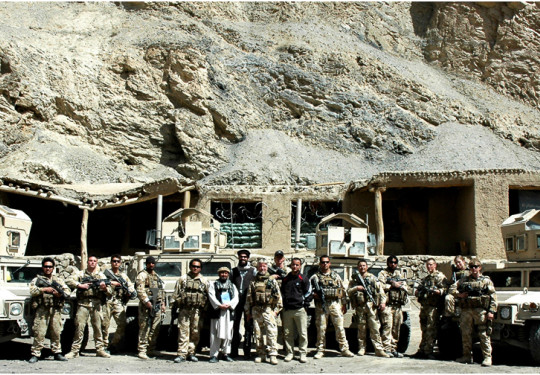CRIB 15
Lieutenant Colonel Martin Dransfield was the Commanding Officer of CRIB 15.
This is his story.
06 September, 2023
In July 2009 I joined my command team in Trentham to receive briefings, prior to deploying via the US air base in Bagram, Afghanistan, to Bamyan. On arrival in Bagram we spent the first few days getting to know our environment, which included many different contributing nations, and an insight into the American approach to warfighting. Eventually a couple of Blackhawk helicopters were made available and we gratefully left the lights and noise of Bagram and climbed into the Hindu Kush and complete darkness as the pilots flew these impressive machines using their night vision goggles. Our destination was Bamiyan and we arrived in a hail of light as our American pilots decided to set off chaff to act as decoys for any potential incoming Surface to Air missiles. As our transport flew off into the night we felt strangely at peace in this silent corner of Afghanistan. We were soon joined by the Chief of Staff of the New Zealand Provincial Reconstruction Team, Lieutenant Colonel Nick Gillard, who was highly amused by the light show we had provided on arrival and commented that he would probably receive a number of complaints from the locals in the morning.
After the initial briefs from CRIB XIV, we spent the next few days patrolling with Major Aidan Shattock, and the Camp Romero patrol, led by Lieutenant Alpha Kennedy, through the rugged and mountainous northern and eastern area of Bamyan.
The scenery was breathtaking and combined incredible rock formations created by nature with equally fantastic human structures that had been chiselled out of the rock by the many different groups of travellers and armies that had trekked through this part of Afghanistan since time immemorial.
Close by were the remains of Shahr-e Gholghola: the city of Gholgolla, or as it became known as the “city of screams”, after Genghis Khan’s army killed all of its inhabitants as an act of retribution after one of the city’s archers killed Khan’s favourite grandson, Mutukan, with a single arrow. The Siege of Bamyan occurred in 1221 during the Mongol pursuit of Jalal ad-Din Mingburnu, the last ruler of the Khwarezmian Empire. Other symbolic structures included Shahr e Zohak: Afghanistan’s Red City, dating back to the 6th Century and built by the Ghorids out of the red mudstone found throughout this mountainous region, and a number of fortifications built successively by Persian, Russian and British armies as they secured various cross roads throughout the area.
My role was the Commander of the New Zealand Provincial Reconstruction Team, which consisted of a number of patrols, who were based in forward operational posts throughout the Bamyan province, including in the northern districts of Kahmard, Sayghan and Shibar and to the west and south in the Yakawlang, Panjab and Waras districts. The headquarters, which included our engineers and police training team, was located next to the new part of Bamiyan city, which included the provincial Afghanistan National Police headquarters and police training centre, and the provincial government buildings.
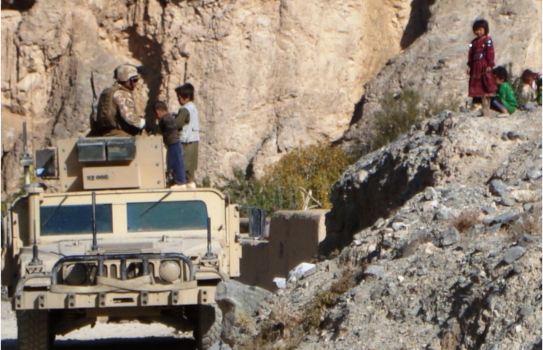
As one of thirty two national Provincial Reconstruction Teams our mission was to support the Provincial Governor, Provincial Council and District Administrators to govern, and to assist the Afghanistan National Police to secure, the province. This objective initially involved regular meetings with the first Afghan provincial female Governor Habiba Sarabi, to discuss governance, development and security. We became great friends and I felt the New Zealand Provincial Reconstruction Team had made enormous progress since its establishment in August 2003, with the development of the Bamyan University, the Bamyan Hospital, and new schools and health centres either functioning, or being built, throughout the province.
But on 12 November, in the Shikari Pass, similar to the Manawatu Gorge, SGT Rangi Rewiti’s patrol came under contact. The first reports were that we had lost a vehicle and up to five soldiers. For the next three hours we called in US air support, and to our great relief, once we had re-established communications, the missing call sign were found intact. Albeit with a few dents in the lead US Army High Mobility Multipurpose Wheeled Vehicle, colloquially known as the Humvee, from RPG rounds. The remainder of the call sign had also been in contact, evidenced by the bullet holes in their vehicle’s windscreens. Whilst this reflected the accuracy of the incoming fire they had sustained, it also demonstrated that the bullet proof windscreens had effectively resisted penetration by the projectiles, and in turn had saved lives.
I was determined to act quickly and to engage with local leaders, at all levels, throughout the province, particularly in the north-east districts of Kahmard and Shibar where we had been attacked, and where the dominant ethnic group were Tajiks. I took a patrol into the area the next day to talk to the local leaders. I discovered that because they were Tajiks they felt that they were not getting the same support as the Hazaras. After some research I discovered that whilst development projects had occurred in the Khamard and Shibar wider area, some of the more isolated areas lacked some key health and education infrastructure. Over the next few months we engaged in dialogue with local groups, in some cases with former Taliban commanders, in order to convince them that we would support them re-build their country. At the same time we harassed and cajoled all those involved in the funding and the contracting of development projects, and eventually won enough resources to start building a road, schools and health clinics in the north-east area. Through a combination of excellent work by the patrols, and in particular their embedded liaison officers whose job was to liaise with the community leaders, and a series of meetings that I attended, alongside the district officials and Afghanistan National Police, we started to win the support of some of the local leaders in the Khamard and Shibar districts, who until then, had seen us as a threat.
During my deployment to Afghanistan I discovered that leaders needed to be your first touchstone when entering into any dialogue. We developed a number of categories, which Major Mikki Mikkelsen and the intelligence team called traditional, religious, elected, appointed and charismatic leaders. Key amongst these were the Heads of Shura, the Mullahs and the former Mujahedeen commanders. I quickly learnt that one of the key imperatives for survival, let alone success, was building relationships with the right people.
On one occasion I was invited with the Bamiyan Chief of Police, General Awaz, to attend a meeting with a number of religious and traditional leaders in a place called Ghandak. Only months before, this area had been the stronghold for the shadow Taliban Provincial Governor Mullah Borhan, and the road leading into and out of Ghandak had been where a number of improvised explosive devices (IEDs) had been laid, one of which had killed an Afghan policeman. After our discussions we went for lunch and General Awaz leaned over and whispered ‘you are lucky to sit amongst these leaders, in previous times you would be dead by now’.
On another occasion the former head of police intelligence during Taliban times, in response to my pointed comment that if we were to complete a roading project in his valley, close to Ghandak, he must assure me that he would not attack my soldiers, he stated “do you think we are stupid, we will not destroy the hand that feeds us”.
In approaching these leaders I developed some strategies. First you must speak some of the language and understand something of who they are. In Afghanistan I learnt some basic Dari in order to demonstrate my respect for their culture, and studied the basic elements of the Koran.
This leads me onto my next observation, that we can, and often do, make the mistake of introducing western norms that are inappropriate to other societies, particularly those regarding corruption, rule of law, and governance.
Sharia Law, which follows a punitive justice model, involves culprits being publicly named, shamed and held accountable for their actions. Of course one faces the dilemma of human rights issues, and people being wrongly accused, but equally western systems allow men guilty of the worst imaginable crimes to walk free based on reasonable doubt.
One day I sat with a Pashtun cleric, Mullah Hashimi, for three hours discussing the topic of bringing to justice a group of bandits who had just murdered a young mother and her baby for a few dollars. We lamented that despite everyone knowing the culprits no-one was coming forward. He blamed this new reality on the recently introduced rule of law and justice processes, and instead espoused a sharia law system that involved an offender facing a local sharia court and admitting their crime. In turn he described that a person facing up to his elders would receive a warning for minor crimes, but admitted that more severe measures were taken for serious crimes. As I sat in his mountain retreat surrounded by severe looking men who eyed me suspiciously, his logic made some sense.
Another area that we widely debated was the training of indigenous forces. In Afghanistan we were training an Army based on individuals who collectively have never been defeated by a modern Army. The First Anglo Afghan campaign involving 15,000 British troops resulted in only one soldier surviving. The Soviet Forces, with all their air power and heavy armour, were decisively defeated by a Mujahedeen Force with very basic weapons, albeit with some Ground to Air missiles from external sources. This outcome was achieved by fighting on ground that totally neutralised their opponent’s superior firepower. In short, I argue that developing operational procedures and tactics in harsh terrain requires us to first study and learn from local successes before imposing our procedures on them. Moreover, after more than a decade, and despite pitting all of our technological superiority against an insurgent force with low level equipment, each year saw more attacks and deaths than in any previous year. There was therefore a degree of inevitability, following the withdrawal of international forces in 2021, that the Afghan National Army would be defeated, largely without a fight, in a matter of days by the Taliban.
The Afghanistan mission was in part focussed on training the Afghan National Army and the Afghan National Police. Again there were positives and negatives. Let me first dwell on the weaknesses, and then turn to some successes. The initial plan involved German, French and British training the Army and the European Union Police, combined with US DynCorp, an American private military contractor, training the ANP. There are children’s stories about why certain animals developed the way they did, based on too many creators, or the oft quoted expression that too many cooks spoil the broth. The result was, in my opinion, a disjointed military and police force, largely trained for conditions unrelated to Afghanistan.
More successful options were the police training centres run by Afghan and international police advisors in the provinces. In Bamyan, for example, New Zealand deployed seasoned policemen who were culturally aware, taught the basics, worked alongside and in support of their Afghan colleagues, and had grey hair and beards – a force multiplier in a traditional society where experience is held in high esteem.
One area that occupied my thoughts during my tour was the use of force. In my experience there is a period when the shock effect of killing an insurgent, particularly a leader, does dissuade other insurgents from continuing, and can remove their local support, which is simply trying to survive and will side with whoever it believes will win. However, the period is short and needs to transition to a focus on negotiation with insurgents, and in particular with their followers, in order to convince them that you are not there to kill them. In fact you need to enter a partnership that includes the insurgents and which will bring the community roads, electricity and jobs. Even more successful are measures that ensure that their wives will not die in child birth, and their kids will live beyond the age of five and get an education.
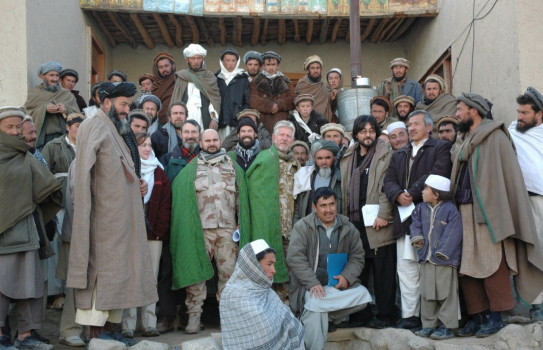
Meeting with Afghan leaders from the Shikari Valley in Gardan Deh. LTCOL Dransfield is centre right in a green traditional Afghan coat.
In Afghanistan I often sat alongside men who had murdered and killed for the smallest of reasons or amounts of money. Yet in each of them I found a father, who wanted nothing more than a better life for his children. I ran many Jirgas in my time in Bamyan, particularly in the Tajik dominated north-east, and discovered that the perception held was that we wanted to arrest, or at worst kill them, and that development projects were for other groups and districts. My job was to win their confidence, but more critically their support. I found that quick impact projects that were put in place by my excellent liaison officers, such as a flood control or a new roof, opened the door but needed to be followed by larger projects that provided employment, and ideally introduced health and education facilities to the district. Underpinning this course was the requirement for Afghans to lead and New Zealanders to support.
To achieve this latter course of action I was ably supported by my United States Department of State advisor, Eric Mehler, and my development team under Major Tony George, who had come out of retirement after many years serving as a military policeman specifically to do the job. Others in his team included our engineering officer, Captain Rosie Mercer, a reservist officer, whose degrees and expertise in Civil Engineering were critical to the successful planning and execution of several construction projects throughout Bamyan alongside her engineer team. In addition we managed to secure a number of United States experts in areas such as Municipal Governance, Provincial Education and Agriculture, who, alongside my Padre Leon O’Flynn willingly joined our patrols throughout Bamiyan to work alongside our liaison officers, and with local leaders.
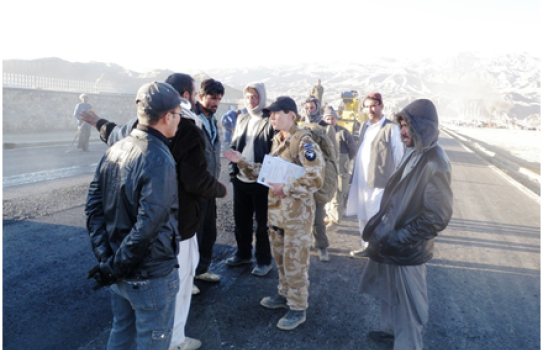
Captain Rosie Mercer with Afghan Engineers discussing a road construction project.
Another area critical to a mission’s success is the effective cooperation of the troop contributing nations. NATO forces, and in particular the US bring a level of technology and expertise that ensures that you can rely on their support for air movement, logistics and medical support and in extremis fire support when you get into trouble. In Afghanistan the speed of reaction from US air medical evacuation assets, Blackhawk helicopters and fast jets was exceptional. As the lead planner for our deployment to Afghanistan in 2003 we had three simple requirements: medical support, logistics support and fast jets on call. We got all three.
So for me Afghanistan provided a clearer understanding of the imperatives to success. Chief amongst these imperatives is a security environment that enables the Provincial Reconstruction Team to operate effectively. The security situation in many parts of Afghanistan prevented this from occurring, but in Bamiyan we were more successful, primarily because we were able to gain the support of the local population. However, there were areas, particularly in the north-east of Bamyan Province and across the provincial border to Baghlan, where this was not the case. Accordingly, we had to first seek out influential leaders, second to listen to and learn from them, third to convince them that we were there to assist not arrest, fourth to deliver results through quick impact projects that provide work and essential infrastructure, and fifth to support longer term projects, that were both sustainable and centred on building human capacity. To defeat insurgents and to build you need to remove their raison d’être, killing only reinforces their cause and expands their support base. In short, to succeed we need to learn from the locals, understand their needs and deliver on promises.
I developed a strong relationship with a number of leaders, and over my tour held numerous meetings either in local restaurants, or in their homes, debating ways forward to bring peace to this distant corner of Afghanistan. Key amongst these heads of Shurah were Mullahs’ Shafiullah and Sarajuddin who walked a dangerous path between working with us to gain projects that would benefit their people, whilst being ever watchful of other more dangerous influences within the region. On our tour, despite the opponents’ best efforts, which particularly involved LT Andy Palmer and CPL John Morrison-MacFarlane’s patrol in the North, who fought through a contact during our handover, we lost no lives and made some significant headway in bringing leaders to the table to discuss development projects and to break down perceptions. Sadly there remained a pocket of hard core insurgents who were determined to kill allied troops, and we took a number of combat casualties in 2010 and 2012.
Afghanistan is a country that will continue to survive despite its deep rooted divisions based on history, tribe and religion. I personally loved the country and its people. Each day provided experiences that were both inspiring and humbling. The hospitality of the Afghan people is second to none. I travelled widely through the Bamyan province, both by foot and vehicle, and was always welcomed into peoples’ houses for Choi (green tea) and roasted almonds. Alongside my loyal interpreters Mustafa Ahmadi, Parwiz Ilyas, and personal protection officer Cpl John Bosman, we spent hours discussing with the locals topics ranging from religion through to the future of Afghanistan.
In leaving Afghanistan I felt that we had, if nothing else, made one small mark, and that was one of perception. I was blessed with a superb command team, including Lieutenant Colonel Peter Hall, WO2 Bradley Fairburn, Major Scotty Cordwell, and Captain Sam Smith. My greatest asset, however, were a number of incredible liaison officers, and courageous patrol commanders, and their teams, who daily patrolled each and every village in the mountains around Bamiyan. The liaison officers conducted community meetings each day, whilst the patrols provided security and delivered books, stationery, medical supplies and most importantly volley balls. In each village they left a child who one day will become a leader of their respective communities and who will remember the soldiers from New Zealand who didn’t come to kill or arrest their parents, but instead to talk and support them.
In conclusion, I remember well my final meeting with Governor Sarabi, the former Mujahideen Commander, Baz Mohamed Khan and, in my opinion, the most prominent figure in the area, Mullah Walli. The latter was a wise individual who stroked his beard, glanced towards the mountains and then to us and lamented that in his opinion “the international support is like the snow melting on the mountains, it is rapidly disappearing.” Those words will always remain with me and it was with great sadness that in 2021, with the departure of the international presence, I saw the Taliban return to Bamyan. Many of the developments, in particular the opportunities for girls and women to achieve their potential, through schools and the Bamyan University, disappeared overnight. It was important, therefore, that we provided the passage for those who worked alongside us in Bamyan to come to New Zealand.
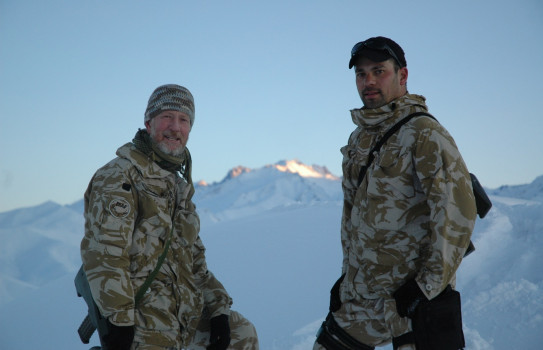
Lieutenant Colonel Martin Dransfield with Corporal John Bosman and the Hindu Kush in the background.
Unclassified Podcast
For more than 20 years the NZDF worked alongside partners in Afghanistan, making a significant contribution to regional security and the lives of the local people.
This year marks a decade since the withdrawal of NZ’s Provincial Reconstruction Team, so we’re bringing you tales of service and sacrifice from those with first-hand experience of life at the front-line.
